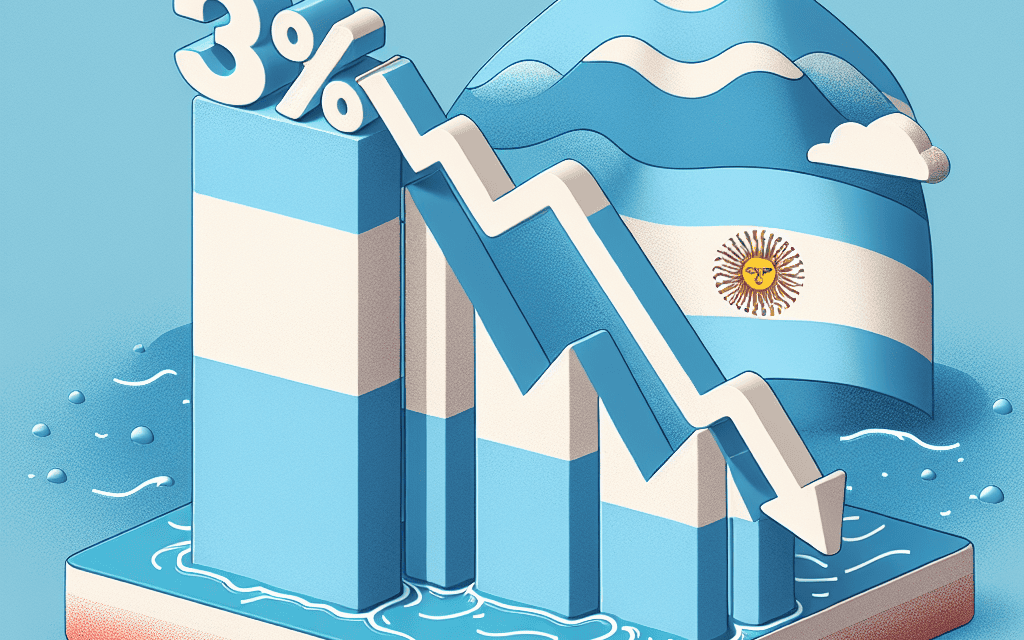“Argentina Eases Inflation: Benchmark Rate Cut to 35% Sparks Economic Optimism”
Introduction
In a strategic move to stimulate economic growth and address easing inflationary pressures, Argentina’s central bank has announced a reduction in its benchmark interest rate to 35%. This decision marks a significant shift in the country’s monetary policy, reflecting a response to the recent stabilization of inflation rates that have historically plagued the Argentine economy. By lowering the benchmark rate, the central bank aims to encourage borrowing and investment, thereby fostering economic activity and supporting the nation’s recovery efforts. This policy adjustment comes as part of a broader strategy to balance inflation control with economic expansion, signaling a cautious optimism about Argentina’s financial outlook.
Impact Of Argentina’s Rate Cut On The Economy
Argentina’s recent decision to lower its benchmark interest rate to 35% marks a significant shift in its monetary policy, reflecting an easing of inflationary pressures that have long plagued the nation. This move, orchestrated by the Central Bank of Argentina, aims to stimulate economic growth by making borrowing more affordable for businesses and consumers alike. As inflation begins to show signs of moderation, the central bank’s decision underscores a strategic pivot towards fostering economic expansion and stability.
The reduction in the benchmark rate is expected to have a multifaceted impact on Argentina’s economy. Primarily, it is anticipated to encourage increased lending activity, as lower interest rates typically reduce the cost of borrowing. This, in turn, can lead to heightened consumer spending and business investment, both of which are crucial drivers of economic growth. By making credit more accessible, the central bank hopes to invigorate sectors that have been sluggish, thereby boosting overall economic productivity.
Moreover, the rate cut is likely to influence the foreign exchange market. A lower interest rate can lead to a depreciation of the national currency, as investors may seek higher returns elsewhere. However, this potential depreciation could be beneficial for Argentina’s export sector. A weaker currency makes Argentine goods more competitive on the international stage, potentially increasing export volumes and improving the trade balance. This could provide a much-needed boost to the country’s foreign exchange reserves, which have been under pressure in recent years.
Nevertheless, the decision to lower the benchmark rate is not without its risks. While the central bank’s move is predicated on the assumption that inflation will continue to ease, any unexpected uptick in inflationary pressures could undermine the benefits of the rate cut. Inflation has been a persistent challenge for Argentina, and maintaining control over it is crucial to ensuring that the economic gains from lower interest rates are not eroded. The central bank will need to remain vigilant, ready to adjust its policy stance should inflationary trends reverse.
In addition to domestic considerations, Argentina’s rate cut must be viewed within the broader context of global economic conditions. The international financial landscape is characterized by uncertainty, with factors such as fluctuating commodity prices and geopolitical tensions influencing economic stability. Argentina’s reliance on agricultural exports makes it particularly sensitive to global market dynamics. Therefore, while the rate cut is a step towards stimulating domestic growth, it must be complemented by strategies that enhance the country’s resilience to external shocks.
Furthermore, the success of this monetary policy adjustment will depend on the government’s ability to implement complementary fiscal policies. Structural reforms aimed at improving the business environment, enhancing infrastructure, and fostering innovation are essential to maximizing the benefits of lower interest rates. By creating a conducive environment for economic activity, Argentina can better position itself to capitalize on the opportunities presented by the rate cut.
In conclusion, Argentina’s decision to lower its benchmark interest rate to 35% is a calculated move aimed at stimulating economic growth amid easing inflation. While the potential benefits are significant, the central bank must navigate a complex landscape of domestic and international challenges. By maintaining a balanced approach and implementing supportive policies, Argentina can harness the power of this rate cut to drive sustainable economic development.
Inflation Trends In Argentina: A Closer Look
Argentina’s economic landscape has been marked by persistent inflationary pressures, which have posed significant challenges for policymakers and the broader economy. Recently, however, there has been a notable shift in the inflationary trend, prompting the central bank to lower the benchmark interest rate to 35%. This decision reflects a broader strategy to stimulate economic growth while managing inflationary expectations. Understanding the implications of this move requires a closer examination of the underlying factors contributing to the easing inflation and the potential impacts on Argentina’s economy.
To begin with, Argentina’s inflation rate has been a focal point of economic policy for several years. Historically, the country has grappled with high inflation, driven by a combination of fiscal imbalances, currency volatility, and external economic pressures. These factors have often necessitated tight monetary policies, including high interest rates, to curb inflation and stabilize the currency. However, recent data indicates a deceleration in inflation, providing a window of opportunity for the central bank to adjust its monetary stance.
The decision to lower the benchmark rate to 35% is rooted in the observed decline in inflationary pressures. Several factors have contributed to this trend. Firstly, global commodity prices have stabilized, reducing the cost-push inflation that has historically affected Argentina’s economy. Additionally, the government’s efforts to implement fiscal reforms and improve public finances have begun to bear fruit, enhancing investor confidence and stabilizing the currency. These developments have collectively contributed to a more favorable inflationary environment, allowing for a more accommodative monetary policy.
Moreover, the central bank’s decision is also influenced by the need to support economic growth. High interest rates, while effective in controlling inflation, can stifle economic activity by increasing borrowing costs for businesses and consumers. By lowering the benchmark rate, the central bank aims to encourage investment and consumption, thereby fostering economic expansion. This move is particularly crucial in the context of Argentina’s ongoing recovery from the economic disruptions caused by the COVID-19 pandemic.
However, it is important to consider the potential risks associated with this policy shift. While easing inflation provides room for lower interest rates, there remains a risk of reigniting inflationary pressures if the policy is not carefully managed. The central bank must remain vigilant and ready to adjust its stance should inflationary trends reverse. Additionally, external factors, such as fluctuations in global commodity prices or changes in international financial conditions, could pose challenges to maintaining a stable inflationary environment.
In conclusion, Argentina’s decision to lower the benchmark interest rate to 35% amid easing inflation marks a significant development in the country’s economic policy landscape. This move reflects a strategic response to the observed decline in inflationary pressures and the need to support economic growth. While the decision presents opportunities for stimulating economic activity, it also necessitates careful monitoring to mitigate potential risks. As Argentina navigates this complex economic environment, the central bank’s ability to balance growth and inflation will be crucial in ensuring sustainable economic progress. The evolving dynamics of inflation and monetary policy in Argentina will continue to be a key area of focus for policymakers, investors, and analysts alike, as they seek to understand and respond to the challenges and opportunities that lie ahead.
How Argentina’s Rate Cut Affects Global Markets
Argentina’s recent decision to lower its benchmark interest rate to 35% marks a significant shift in its monetary policy, reflecting an easing of inflationary pressures within the country. This move, orchestrated by the Central Bank of Argentina, is aimed at stimulating economic growth by making borrowing more affordable for businesses and consumers. As inflation begins to show signs of moderation, the central bank has seized the opportunity to adjust its policy stance, hoping to foster a more conducive environment for economic recovery. However, the implications of this rate cut extend beyond Argentina’s borders, influencing global markets in various ways.
To understand the broader impact, it is essential to consider Argentina’s role in the global economy. As one of the largest economies in Latin America, Argentina’s economic policies can have ripple effects throughout the region. The reduction in interest rates is likely to encourage increased investment within the country, as lower borrowing costs make it more attractive for both domestic and foreign investors to finance projects. This influx of investment could lead to a strengthening of the Argentine peso, which, in turn, may affect trade balances with neighboring countries. Consequently, regional markets may experience shifts in capital flows, as investors reassess their portfolios in light of Argentina’s changing economic landscape.
Moreover, Argentina’s decision to lower interest rates comes at a time when many central banks around the world are grappling with the challenge of balancing inflationary pressures against the need to support economic growth. In this context, Argentina’s move may serve as a reference point for other emerging markets facing similar dilemmas. By demonstrating a willingness to adapt monetary policy in response to changing economic conditions, Argentina sets a precedent that could influence the policy decisions of other nations. This is particularly relevant for countries that share similar economic characteristics, such as high inflation rates and volatile currency markets.
Furthermore, the rate cut in Argentina may have implications for global commodity markets. As a major exporter of agricultural products, Argentina’s economic health is closely tied to the performance of its agricultural sector. Lower interest rates could lead to increased agricultural production, as farmers and agribusinesses take advantage of cheaper financing options to expand operations. This potential boost in supply could exert downward pressure on global commodity prices, affecting markets for products such as soybeans, corn, and wheat. Consequently, countries that rely heavily on agricultural exports may need to adjust their strategies in response to changing market dynamics.
In addition to these economic considerations, Argentina’s rate cut also carries political implications. The decision reflects the government’s commitment to addressing inflation while simultaneously promoting growth, a balancing act that is crucial for maintaining public confidence. As Argentina navigates its economic challenges, the international community will be closely monitoring the outcomes of this policy shift. Success in stabilizing the economy could enhance Argentina’s standing on the global stage, potentially leading to increased foreign investment and stronger diplomatic ties.
In conclusion, Argentina’s decision to lower its benchmark interest rate to 35% amid easing inflation is a strategic move with far-reaching consequences. By fostering a more favorable environment for economic growth, the central bank aims to revitalize the domestic economy while also influencing global markets. As investors and policymakers around the world assess the implications of this rate cut, Argentina’s actions may serve as a catalyst for broader discussions on monetary policy and economic strategy in the face of evolving global challenges.
Historical Context Of Argentina’s Monetary Policy

Argentina’s monetary policy has long been a subject of intense scrutiny and debate, both domestically and internationally. The recent decision to lower the benchmark interest rate to 35% marks a significant shift in the country’s economic strategy, reflecting a broader historical context of fluctuating monetary policies aimed at stabilizing an often volatile economy. To understand the implications of this move, it is essential to delve into the historical backdrop that has shaped Argentina’s approach to monetary policy over the decades.
Historically, Argentina has grappled with high inflation rates, a challenge that has persisted through various political and economic regimes. The roots of this issue can be traced back to the mid-20th century when the country experienced rapid industrialization and urbanization. During this period, expansionary fiscal policies were often employed to stimulate growth, inadvertently leading to inflationary pressures. As a result, the central bank frequently resorted to high interest rates as a tool to curb inflation, a strategy that has been a recurring theme in Argentina’s economic narrative.
In the late 20th century, Argentina faced one of its most severe economic crises, culminating in the hyperinflation of the late 1980s. This period saw inflation rates soar to unprecedented levels, eroding public confidence in the national currency and prompting a series of monetary reforms. The introduction of the Convertibility Plan in the early 1990s, which pegged the Argentine peso to the US dollar, was a bold attempt to stabilize the economy. While initially successful in curbing inflation, the rigid exchange rate regime eventually led to economic stagnation and a financial crisis in 2001.
In the aftermath of the crisis, Argentina adopted a more flexible exchange rate system, allowing for greater monetary policy autonomy. However, the challenge of inflation persisted, with rates often exceeding double digits. In response, the central bank oscillated between tightening and loosening monetary policy, striving to strike a balance between controlling inflation and fostering economic growth. This delicate balancing act has been a defining feature of Argentina’s monetary policy in the 21st century.
The recent decision to lower the benchmark rate to 35% comes amid signs of easing inflation, offering a glimmer of hope for a more stable economic environment. This move is indicative of a broader trend towards accommodative monetary policy, aimed at stimulating investment and consumption in a bid to bolster economic recovery. By reducing borrowing costs, the central bank hopes to encourage businesses and consumers to spend and invest, thereby driving economic growth.
Nevertheless, this policy shift is not without its risks. Lowering interest rates could potentially reignite inflationary pressures, a concern that remains at the forefront of policymakers’ minds. To mitigate this risk, the central bank must remain vigilant, ready to adjust its policy stance should inflationary trends re-emerge. Moreover, the success of this strategy hinges on broader structural reforms, including efforts to enhance fiscal discipline and improve the business environment.
In conclusion, Argentina’s decision to lower the benchmark rate to 35% is a reflection of its ongoing struggle to navigate the complex interplay between inflation control and economic growth. This move, set against a backdrop of historical monetary policy challenges, underscores the central bank’s commitment to fostering a more stable and prosperous economic future. As Argentina continues to grapple with these issues, the lessons of the past will undoubtedly inform its path forward, shaping the contours of its monetary policy for years to come.
The Role Of Central Banks In Inflation Control
Central banks play a pivotal role in managing a country’s economic stability, primarily through the regulation of inflation. Inflation, the rate at which the general level of prices for goods and services rises, erodes purchasing power and can destabilize economies if left unchecked. Central banks, therefore, employ various monetary policy tools to control inflation, with interest rates being one of the most significant. Recently, Argentina’s central bank made headlines by lowering its benchmark interest rate to 35%, a move that reflects an easing inflationary environment in the country.
Interest rates are a primary tool used by central banks to influence economic activity. By adjusting these rates, central banks can either encourage borrowing and spending or promote saving and reduce spending. In Argentina’s case, the decision to lower the benchmark rate is indicative of a strategic shift aimed at stimulating economic growth. This move comes as inflationary pressures in the country have shown signs of abating, providing the central bank with the leeway to adopt a more accommodative monetary stance.
The decision to lower interest rates is not made lightly, as it involves a careful assessment of various economic indicators. Central banks must consider the current inflation rate, economic growth forecasts, and other macroeconomic variables. In Argentina, the central bank’s decision suggests confidence that inflation is under control, allowing for a reduction in rates to support economic recovery. This is particularly important in a country that has historically grappled with high inflation rates, which have often necessitated stringent monetary policies.
Moreover, the role of central banks extends beyond mere inflation control. They are also tasked with ensuring financial stability and fostering conditions conducive to sustainable economic growth. By lowering interest rates, Argentina’s central bank aims to reduce the cost of borrowing, thereby encouraging investment and consumption. This, in turn, can lead to job creation and increased economic activity, which are crucial for a country seeking to recover from economic downturns.
However, it is essential to recognize that while lowering interest rates can stimulate economic growth, it also carries potential risks. If not carefully managed, such a policy could lead to excessive borrowing and asset bubbles, which might pose challenges to financial stability in the long run. Therefore, central banks must strike a delicate balance between promoting growth and maintaining economic stability.
In addition to interest rate adjustments, central banks employ other tools such as open market operations and reserve requirements to manage liquidity in the economy. These measures, combined with interest rate policies, form a comprehensive approach to controlling inflation and ensuring economic stability. In Argentina, the central bank’s recent actions underscore its commitment to using all available tools to navigate the complex economic landscape.
In conclusion, the role of central banks in inflation control is multifaceted and requires a nuanced understanding of economic dynamics. Argentina’s decision to lower its benchmark rate to 35% highlights the central bank’s proactive approach in responding to changing inflationary conditions. As inflation eases, the central bank’s focus shifts towards fostering economic growth while remaining vigilant to potential risks. This delicate balancing act underscores the critical role central banks play in shaping economic policy and ensuring long-term stability.
Economic Challenges Facing Argentina In 2023
In 2023, Argentina continues to grapple with a complex array of economic challenges, with inflation being a persistent and formidable adversary. Recently, the Argentine central bank made a significant move by lowering its benchmark interest rate to 35%, a decision that reflects a cautious optimism about the country’s inflationary trajectory. This adjustment comes amid signs of easing inflationary pressures, offering a glimmer of hope for an economy that has long been beleaguered by financial instability.
The decision to reduce the benchmark rate is not merely a reaction to current inflation trends but also a strategic maneuver aimed at stimulating economic growth. By lowering the cost of borrowing, the central bank hopes to encourage investment and consumer spending, which are crucial for revitalizing an economy that has been stagnant for several years. However, this move is not without its risks. Lower interest rates can potentially lead to an overheating economy if not carefully managed, especially in a country like Argentina, where inflation has historically been volatile.
Moreover, the central bank’s decision is set against a backdrop of broader economic reforms that the government is attempting to implement. These reforms are designed to address structural issues that have long plagued the Argentine economy, such as fiscal deficits and a lack of competitiveness in certain sectors. By fostering a more conducive environment for business and investment, the government aims to lay the groundwork for sustainable economic growth. Nevertheless, the success of these reforms is contingent upon a delicate balance between stimulating growth and maintaining fiscal discipline.
In addition to domestic challenges, Argentina must also navigate a complex international economic landscape. Global economic conditions, including fluctuating commodity prices and shifting trade dynamics, have a significant impact on Argentina’s economy. As a major exporter of agricultural products, Argentina is particularly sensitive to changes in global demand and prices. Therefore, the central bank’s decision to lower the interest rate must also be viewed in the context of these external factors, which can either amplify or mitigate the effects of domestic policy measures.
Furthermore, the Argentine government faces the daunting task of managing its substantial debt obligations. In recent years, Argentina has engaged in negotiations with international creditors to restructure its debt, seeking more favorable terms that would alleviate some of the financial pressures on the economy. The success of these negotiations is critical, as it would provide the government with greater fiscal space to implement its economic agenda. However, achieving a sustainable debt solution requires not only diplomatic acumen but also a credible commitment to economic reform.
In conclusion, while the decision to lower the benchmark interest rate to 35% is a positive step towards addressing Argentina’s economic challenges, it is by no means a panacea. The path to economic stability and growth is fraught with obstacles, both domestic and international. It requires a comprehensive approach that combines sound monetary policy with structural reforms and prudent fiscal management. As Argentina navigates this complex economic landscape, the central bank’s actions will play a crucial role in shaping the country’s economic future. The coming months will be critical in determining whether these efforts will yield the desired outcomes, as Argentina strives to overcome its economic challenges and achieve a more stable and prosperous future.
Future Projections For Argentina’s Economic Growth
Argentina’s recent decision to lower its benchmark interest rate to 35% marks a significant shift in its monetary policy, reflecting a cautious optimism about the country’s economic trajectory. This move comes amid signs of easing inflation, a development that has provided the central bank with some leeway to stimulate economic growth. As Argentina navigates this complex economic landscape, the implications of this rate cut are multifaceted, influencing various aspects of the nation’s future economic growth.
To begin with, the reduction in the benchmark rate is expected to lower borrowing costs, thereby encouraging both consumer spending and business investment. By making credit more accessible, the central bank aims to invigorate domestic demand, which is crucial for economic recovery. This strategy is particularly pertinent given the recent challenges Argentina has faced, including high inflation rates that have eroded purchasing power and stifled economic activity. With inflation showing signs of moderation, the timing of this rate cut could be pivotal in fostering a more conducive environment for economic expansion.
Moreover, the decision to lower interest rates is likely to have a positive impact on Argentina’s financial markets. Lower rates can lead to increased liquidity, which in turn can boost investor confidence and attract foreign investment. This influx of capital is essential for Argentina, as it seeks to stabilize its economy and reduce its reliance on external debt. By creating a more attractive investment climate, the country can potentially enhance its economic resilience and lay the groundwork for sustainable growth.
However, it is important to consider the potential risks associated with this monetary policy adjustment. While the easing of inflation provides some justification for the rate cut, there remains a possibility that inflationary pressures could resurface. If inflation begins to rise again, the central bank may find itself in a challenging position, needing to balance the goals of stimulating growth and maintaining price stability. Therefore, careful monitoring of inflation trends will be crucial in the coming months to ensure that the benefits of the rate cut are not undermined by a resurgence of inflation.
In addition to domestic factors, Argentina’s economic growth prospects are also influenced by external conditions. The global economic environment, characterized by uncertainties such as fluctuating commodity prices and geopolitical tensions, can have significant implications for Argentina’s export-driven sectors. As such, the country’s ability to capitalize on the opportunities presented by the rate cut will depend on its capacity to navigate these external challenges effectively.
Looking ahead, the success of Argentina’s economic strategy will hinge on a combination of sound monetary policy, structural reforms, and prudent fiscal management. The rate cut is a step in the right direction, but it must be complemented by efforts to address underlying structural issues, such as improving productivity, enhancing competitiveness, and fostering innovation. By adopting a holistic approach to economic policy, Argentina can position itself for a more robust and sustainable growth trajectory.
In conclusion, Argentina’s decision to lower its benchmark rate to 35% amid easing inflation is a strategic move aimed at stimulating economic growth. While the potential benefits are significant, the path forward is fraught with challenges that require careful navigation. By maintaining a focus on both domestic and external factors, and by implementing complementary policy measures, Argentina can enhance its prospects for future economic growth and stability.
Q&A
1. **What is the new benchmark interest rate set by Argentina?**
The new benchmark interest rate set by Argentina is 35%.
2. **Why did Argentina decide to lower its benchmark interest rate?**
Argentina lowered its benchmark interest rate due to easing inflation.
3. **What was the previous benchmark interest rate before the reduction?**
The previous benchmark interest rate was higher than 35%, but the exact figure would need to be specified based on the context.
4. **How does a lower benchmark interest rate affect the economy?**
A lower benchmark interest rate generally aims to stimulate economic growth by making borrowing cheaper, encouraging spending and investment.
5. **What is the central bank’s role in adjusting the benchmark interest rate?**
The central bank adjusts the benchmark interest rate to manage economic stability, control inflation, and influence economic growth.
6. **What impact does easing inflation have on monetary policy decisions?**
Easing inflation can lead to a more accommodative monetary policy, allowing for lower interest rates to support economic activity.
7. **What are potential risks of lowering the benchmark interest rate?**
Potential risks include overheating the economy, increasing debt levels, and potentially leading to future inflation if not managed carefully.
Conclusion
Argentina’s decision to lower its benchmark interest rate to 35% reflects a strategic response to easing inflationary pressures. By reducing the rate, the central bank aims to stimulate economic growth by making borrowing more affordable, encouraging investment, and boosting consumer spending. This move indicates confidence in the country’s inflation trajectory and suggests a shift towards a more accommodative monetary policy. However, the effectiveness of this strategy will depend on maintaining inflation control and ensuring that the lower rates translate into tangible economic benefits without triggering financial instability or undermining currency value.





